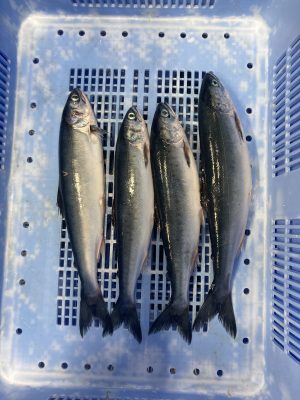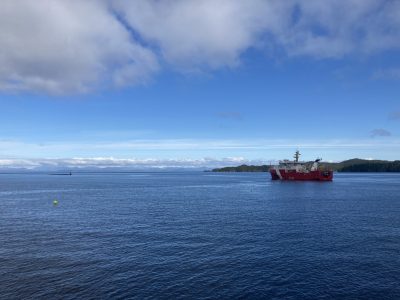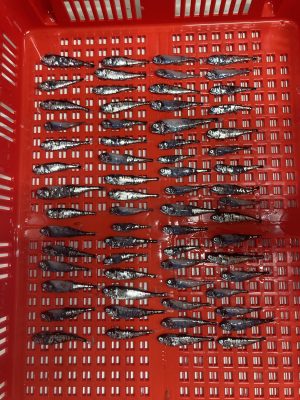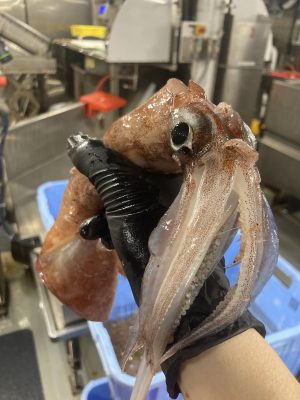
Pink salmon samples ©Anna McLaskey
For scientists in the IOF’s Pelagic Ecosystems Lab, the trip represents a chance to trace the outline of North Pacific food webs, in which salmon play a central role as both predator and prey.
“Food web models illustrate the important components of ecosystems, and how different species that share the same space interact with one another through what they eat,” said Genyffer Troina, a postdoctoral fellow who travelled through the Gulf of Alaska on American ship NOAA Bell M. Shimada.

Net preparation ©Anna McLaskey
Troina is using two biochemical tools – stable isotopes and fatty acids – in pursuit of this mission. These two “biomarkers” are like fingerprints that can reveal what an organism has been eating, and can be used to map out the North Pacific food web, from plankton to salmon.
Early insights from the trip have already begun to shape the questions that will guide Troina’s work in the coming months.
“We saw that the catch was either dominated by a lot of different species of jellyfish and then only a few salmon and not much else, or almost no jellyfish at all and then a lot of juvenile squid and forage fish, some krill, some bigger squids, and more salmon,” she said. “What is driving that difference in the dominance of species? Does it relate to temperature, or is there a missing competitor in the jellyfish-dominated ecosystem?”

CCGS Sir John Franklin ©Anna McLaskey
Specifically, McLaskey wants to understand how zooplankton are affected by nutritional changes to phytoplankton, the ocean plants on which zooplankton feed. These nutritional changes may work their way up to salmon and other fish that prey on zooplankton.
The data collected on the IYS trip will help to produce a map of how the nutritional value of zooplankton varies across the North Pacific. Since zooplankton are the cornerstone of salmon’s diet, this information is key to understanding spatial differences in salmon health.
“It’s interesting being able to cover all of that space in a couple weeks and see the differences in the zooplankton communities, especially north to south,” said McLaskey, who was on board Canadian ship CCGS Sir John Franklin.
During the easternmost section of the Pacific leg of her journey, McLaskey inspected salmon stomachs to see exactly which zooplankton the fish were consuming.

Myctophods ©Anna McLaskey
For Brian Hunt, the principal investigator of the Pelagic Ecosystems Lab, the IYS expedition is a rare opportunity to collect data from the open ocean, and least-known life stage of Pacific Salmon. It will be crucial for understanding how salmon respond to climate change.
“You are what you eat. Without healthy food webs, salmon will not get the nutrition they need. This means that they won’t grow well, they will have less speed to escape predators, they will be more susceptible to disease, they are more likely not to successfully make it back to their spawning rivers, and will produce less healthy eggs and young,” Hunt said. “That’s why we care about the food web.”
Now that the expedition is finished, Hunt thinks that the team will start to uncover new findings by as early as this summer.

Squid ©Anna McLaskey
Tags: Anna McLaskey, Brian Hunt, faculty, food webs, Genyffer Troina, Gulf of Alaska, International Year of the Salmon, IOF postdoctoral fellows, jellyfish, plankton, Research, salmon, squid, zooplankton